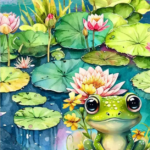Flour and Dreams:
In the heart of a bustling city, there lived a young man named Elias. His soul danced to the rhythm of colors, and his dreams soared higher than the tallest skyscrapers. Elias yearned to be a famous artist, but life had dealt him a hand of scarcity.
His tiny apartment was a canvas of struggle. The walls, once pristine white, now bore the scars of time. The only furniture was a rickety table, and the window offered a view of the neighboring brick wall. But Elias refused to let his circumstances dim the fire within him.
Every morning, he would rise with the sun, his heart echoing the promise of a new day. He’d gaze out of the window, imagining the world beyond those bricks—a world where his art would breathe life into forgotten stories.
Yet, the path to fame was paved with obstacles. Elias couldn’t afford the luxurious paints, the silky canvases, or the elegant brushes. His pockets were as empty as the cardboard boxes he scavenged from the alley behind his building.
But Elias was resourceful. He collected discarded cardboard, flattening it meticulously until it resembled a canvas. His palette? A humble mixture of colored flour—borrowed from the bakery downstairs. The flour was his secret weapon, a magic potion that transformed mundane cardboard into vibrant landscapes.
His makeshift easel stood before him: a flattened cardboard box rescued from the recycling bin. Its edges bore the scars of its previous life, but Elias saw potential in every crease. The flour-based paint, mixed with water, lay in small bowls beside him—a palette of muted colors that whispered stories of resilience.
Elias painted with fervor. His fingers, stained with hues of ochre and cobalt, danced across the cardboard. Paintings that transcend time and place like whispers carried across centuries, their brushstrokes echoing through epochs. They exist in a liminal space—neither bound by the present nor tethered to the past. Elias’s art was raw, unpolished, but it held a truth that no expensive brush could replicate.
People passing by would pause, their eyes drawn to the makeshift gallery outside his window. They’d whisper, “Who is this mysterious artist?” Elias reveled in their curiosity, knowing that his art transcended the boundaries of wealth.
One day, a gallery owner named Ms. Harper stumbled upon Elias’s display. She was a woman of discerning taste, her heels clicking against the pavement as she examined each piece. Elias watched from behind the curtain, his heart pounding.
Ms. Harper’s eyes widened when she saw the cardboard masterpiece—an old man feeding pigeons in the park. The flour strokes captured the wrinkles on the man’s face, the joy in his eyes. His eyes crinkle at the corners, as if he’s glimpsed secrets whispered by the wind. She turned to Elias, her expression a mix of awe and disbelief.
“Who are you?” she asked.
“Elias,” he replied, his voice trembling. “Just Elias.”
Ms. Harper invited him to her gallery. Elias stepped into a world of polished floors and velvet ropes. His cardboard art hung alongside masterpieces worth fortunes. The contrast was stark, but Elias held his head high.
The critics were divided. Some scoffed at the unconventional medium, dismissing it as a gimmick. But others—the dreamers—saw the truth. Elias’s art spoke of resilience, of dreams that defied poverty. The gallery buzzed with whispers, and soon, the newspapers caught wind of the phenomenon.
“The Flour Artist” they called him. Elias’s fame spread like wildfire. His cardboard canvases sold for thousands, and collectors vied for a glimpse of his next creation. But Elias remained grounded. He still borrowed flour from the bakery, still painted by the window, still dreamed of the world beyond the bricks.
And so, Elias became a famous artist—not because of his wealth, but because of his unwavering spirit. His legacy wasn’t in gold-framed paintings but in the hearts of those who saw beauty where others saw scarcity.
As the sun dipped below the horizon, Elias stood by his window, gazing at the city he had immortalized. The cardboard fluttered in the evening breeze, and he whispered, “Dreams are like flour—they turn the ordinary into magic.”
And so, Elias painted on, his heart ablaze with colors, his dreams soaring higher than the skyscrapers. For in the humblest of materials, he found the true essence of art—a testament to the indomitable human spirit.
Elias’s story reminds us that creativity knows no bounds, and dreams can flourish even in the most unlikely places.



























